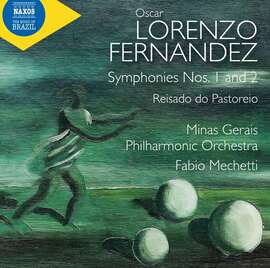Von Oscar Lorenzo Fernández (1897-1948) kannte ich bisher nur Batuque, ein Stück, das Arturo Toscanini bekannt gemacht hat. Dass dieser brasilianische Komponist aber viel mehr zu bieten hat, zeigt dieses ausgezeichnete Album.
Nach Ansicht des brasilianischen Musikwissenschaftlers Vasco Mariz lassen sich die Werke von Oscar Lorenzo Fernández (1897-1948) in drei Perioden einteilen. Die erste Periode (1918-1922) war die Zeit, in der er von der europäischen Musik der Romantik und des Impressionismus beeinflusst wurde. In der zweiten Periode (1923-1938) schuf er repräsentative Werke des brasilianischen Nationalismus. In diese Periode fällt Reisado do Pastoreio, eine 1941 komponierte Orchestersuite über Themen aus der Oper Malazarte. Die Suite besteht aus einem pastoralen Pastoreio, dem tänzerischen Toada und eben dem von Toscanini zu weltweiter Beachtung gebrachten, sehr rhythmisch-perkussiven Batuque. Der Name stammt übrigens von der Religion, die von ehemaligen Sklaven afrikanischer Herkunft praktiziert wurde, Batuque, die sich Mitte des 19. Jahrhunderts in der Region Rio Grande do Sul bis nach Argentinien und Uruguay verbreitete.
In der dritten Schaffensperiode (1939-1948) wandte sich der Komponist vom Nationalismus ab und wurde zum Universalisten.
Die Erste Symphonie entstand 1945 und wenn sie auch formal vom Nationalismus abweicht, so kann Lorenzo Fernandez seine Herkunft nicht verleugnen. Zudem hat man immer den Eindruck, seine Musik habe ein Programm und erzähle eine Geschichte. Der zweite Satz, Allegro vivo, scherzoso, ist rhythmisch und deutlich auf brasilianischer Folklore basiert.
Der dritte Satz ist düster und dramatisch, der vierte ist kontrastreich zwischen leidenschaftlich dramatischen und lyrisch-ruhigen Passagen. Immer wieder überraschen das Narrative und die Fülle der Ideen dieses äußerst fantasievollen Komponisten.
Die Symphonie Nr. 2 in E-Dur (O Caçador de Esmeraldas) entstand zwischen 1946 und 1947 und ist ganz klar eine programmatische Symphonie, die vom Text des gleichnamigen epischen Gedichts des Dichters Olavo Bilac (1865-1918) inspiriert ist und von Männern handelt, die in den Urwald vordrangen, um dort Smaragde und Reichtum zu finden. Die Musik ist eine klangliche Abbildung dieses Kampfes gegen die Gefahren des Urwalds und entsprechend dramatisch. Sie ist packend wegen der Fülle an musikalischem Material und an eingängiger Rhythmik, endet aber ruhig: der Held stirbt an Gelbfieber und kann den errungenen Reichtum nicht genießen.
Die Interpretationen des Orchesters aus Minas Gerais sind engagiert und von gutem Niveau, so dass die Musik des Komponisten eindrucksvoll wiedergegeben wird und man für dieses Album eine eindeutige Empfehlung aussprechen kann.
Until now, I only knew Batuque by Oscar Lorenzo Fernández (1897-1948), a piece that Arturo Toscanini made famous. But this excellent album shows that this Brazilian composer has much more to offer.
According to the Brazilian musicologist Vasco Mariz, the works of Oscar Lorenzo Fernández (1897-1948) can be divided into three periods. The first period (1918-1922) was the time in which he was influenced by the European music of Romanticism and Impressionism. In the second period (1923-1938), he created representative works of Brazilian nationalism. Reisado do Pastoreio, an orchestral suite composed in 1941 on themes from the opera Malazarte, falls into this period. The suite consists of a pastoral Pastoreio, the dance-like Toada and the very rhythmic and percussive Batuque, which Toscanini brought to worldwide attention. Incidentally, the name comes from the religion practiced by former slaves of African origin, Batuque, which spread from the Rio Grande do Sul region to Argentina and Uruguay in the middle of the 19th century.
In the third creative period (1939-1948), the composer turned away from nationalism and became a universalist.
The First Symphony was composed in 1945 and although it formally departs from nationalism, Lorenzo Fernandez cannot deny his origins. Moreover, one always has the impression that his music has a program and tells a story. The second movement, Allegro vivo, scherzoso, is rhythmic and clearly based on Brazilian folklore
The third movement is somber and dramatic, the fourth is rich in contrast between passionately dramatic and lyrically calm passages. The narrative and the wealth of ideas of this extremely imaginative composer never cease to surprise.
Symphony No. 2 in E major (O Caçador de Esmeraldas) was composed between 1946 and 1947 and is clearly a programmatic symphony inspired by the text of the epic poem of the same name by the poet Olavo Bilac (1865-1918), about men who penetrated the jungle to find emeralds and richness. The music is a tonal depiction of this struggle against the dangers of the jungle and is correspondingly dramatic. It is gripping due to the abundance of musical material and catchy rhythms, but ends quietly: the hero dies of yellow fever and cannot enjoy the richness he has won.
The interpretations by the orchestra from Minas Gerais are committed and of a good standard, so that the composer’s music is impressively rendered and this album can be unequivocally recommended.


















